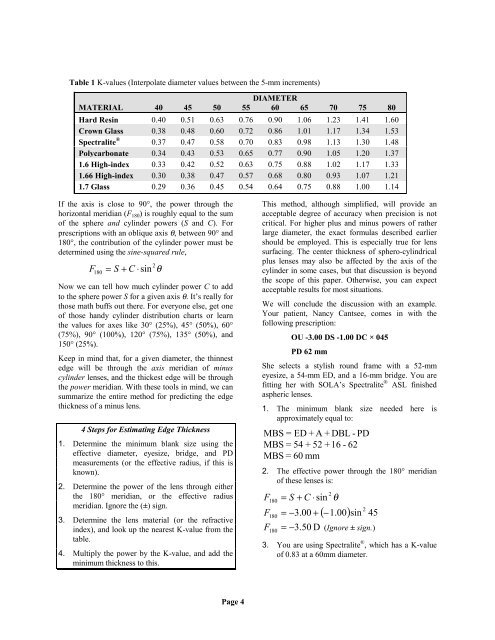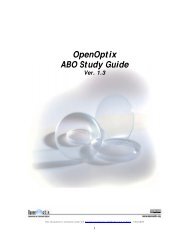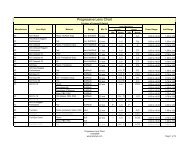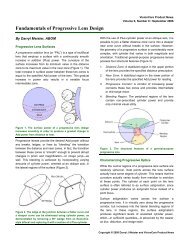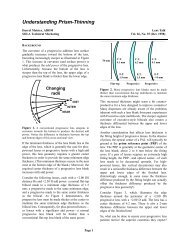Methods for Estimating Lens Thickness - Laramy-K Optical
Methods for Estimating Lens Thickness - Laramy-K Optical
Methods for Estimating Lens Thickness - Laramy-K Optical
Create successful ePaper yourself
Turn your PDF publications into a flip-book with our unique Google optimized e-Paper software.
Table 1 K-values (Interpolate diameter values between the 5-mm increments)<br />
DIAMETER<br />
MATERIAL 40 45 50 55 60 65 70 75 80<br />
Hard Resin 0.40 0.51 0.63 0.76 0.90 1.06 1.23 1.41 1.60<br />
Crown Glass 0.38 0.48 0.60 0.72 0.86 1.01 1.17 1.34 1.53<br />
Spectralite ® 0.37 0.47 0.58 0.70 0.83 0.98 1.13 1.30 1.48<br />
Polycarbonate 0.34 0.43 0.53 0.65 0.77 0.90 1.05 1.20 1.37<br />
1.6 High-index 0.33 0.42 0.52 0.63 0.75 0.88 1.02 1.17 1.33<br />
1.66 High-index 0.30 0.38 0.47 0.57 0.68 0.80 0.93 1.07 1.21<br />
1.7 Glass 0.29 0.36 0.45 0.54 0.64 0.75 0.88 1.00 1.14<br />
If the axis is close to 90°, the power through the<br />
horizontal meridian (F 180 ) is roughly equal to the sum<br />
of the sphere and cylinder powers (S and C). For<br />
prescriptions with an oblique axis θ, between 90° and<br />
180°, the contribution of the cylinder power must be<br />
determined using the sine-squared rule,<br />
F<br />
2<br />
180 = S + C ⋅sin<br />
θ<br />
Now we can tell how much cylinder power C to add<br />
to the sphere power S <strong>for</strong> a given axis θ. It’s really <strong>for</strong><br />
those math buffs out there. For everyone else, get one<br />
of those handy cylinder distribution charts or learn<br />
the values <strong>for</strong> axes like 30° (25%), 45° (50%), 60°<br />
(75%), 90° (100%), 120° (75%), 135° (50%), and<br />
150° (25%).<br />
Keep in mind that, <strong>for</strong> a given diameter, the thinnest<br />
edge will be through the axis meridian of minus<br />
cylinder lenses, and the thickest edge will be through<br />
the power meridian. With these tools in mind, we can<br />
summarize the entire method <strong>for</strong> predicting the edge<br />
thickness of a minus lens.<br />
4 Steps <strong>for</strong> <strong>Estimating</strong> Edge <strong>Thickness</strong><br />
1. Determine the minimum blank size using the<br />
effective diameter, eyesize, bridge, and PD<br />
measurements (or the effective radius, if this is<br />
known).<br />
2. Determine the power of the lens through either<br />
the 180° meridian, or the effective radius<br />
meridian. Ignore the (±) sign.<br />
3. Determine the lens material (or the refractive<br />
index), and look up the nearest K-value from the<br />
table.<br />
4. Multiply the power by the K-value, and add the<br />
minimum thickness to this.<br />
This method, although simplified, will provide an<br />
acceptable degree of accuracy when precision is not<br />
critical. For higher plus and minus powers of rather<br />
large diameter, the exact <strong>for</strong>mulas described earlier<br />
should be employed. This is especially true <strong>for</strong> lens<br />
surfacing. The center thickness of sphero-cylindrical<br />
plus lenses may also be affected by the axis of the<br />
cylinder in some cases, but that discussion is beyond<br />
the scope of this paper. Otherwise, you can expect<br />
acceptable results <strong>for</strong> most situations.<br />
We will conclude the discussion with an example.<br />
Your patient, Nancy Cantsee, comes in with the<br />
following prescription:<br />
OU -3.00 DS -1.00 DC × 045<br />
PD 62 mm<br />
She selects a stylish round frame with a 52-mm<br />
eyesize, a 54-mm ED, and a 16-mm bridge. You are<br />
fitting her with SOLA’s Spectralite ® ASL finished<br />
aspheric lenses.<br />
1. The minimum blank size needed here is<br />
approximately equal to:<br />
MBS = ED + A + DBL - PD<br />
MBS = 54 + 52 +16 - 62<br />
MBS = 60 mm<br />
2. The effective power through the 180° meridian<br />
of these lenses is:<br />
F<br />
F<br />
2<br />
180 = S + C ⋅ sin θ<br />
180 = −3.00<br />
+ −<br />
180 = −3.50 D<br />
2<br />
( 1.00) sin 45<br />
F (Ignore ± sign.)<br />
3. You are using Spectralite ® , which has a K-value<br />
of 0.83 at a 60mm diameter.<br />
Page 4


